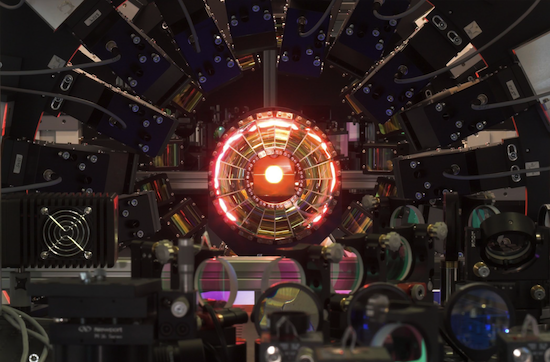Pulsed laser power
Someone asked me recently how peak power related to average power for pulsed lasers. You can get fancy with this calculation, but people rarely do. 99% of the time, people assume square pulses, and then this is the answer:
Peak power = Average power / (Pulse rate * Pulse width)
For example, 3 watts of average power for a typical Ti:Sapph (80MHz, 100fs) corresponds to a peak power of: (3 watts) / (80e6 * 100e-15) = 375 kW.
Relatedly, if you want to know the energy per pulse (another commonly cited measure), it is simply the average power divided by the pulse rate. Using the same example numbers as above, we get 37.5 nJ.
While I’m throwing around useful but imprecise equations, I’ll add that the pulse width can be estimated by measuring the spectral spread (pulsed lasers don’t emit a single wavelength of light, they emit a distribution of different wavelengths). The product of the spectral spread and the pulse width should be roughly equal to some constant as they vary. One goes up, the other goes down. In practice, 70fs pulses from a Ti:Sapph cover a spectrum of about 13nm, and 100fs pulses cover about 10nm. So, the product is about 10^-21 m-s.

[…] relatively low, but during a pulse, the probability of a 2-photon event is relatively high. But as discussed earlier, these short pulse durations are paired with large spectral spreads. For 100 fs pulses, the spread […]
Dear Sir
Greetings
To trigger a lightning, UV laser beam is used.
Now,
1- What is the consumed power in the triggering apparatus to trigger one lighting charge?
2- How much is the lightning charge that is triggered, in power, current and voltage?
Regards
Farid Fahim
E – mail : logic_co@hotmail.com
[…] a previous post, we discussed how peak power is computed. Although Ti:Sapph laser manufacturers typically quote the […]
[…] Peak power: 375 kW Energy: 37.5 nJ (calculation notes, more info) […]
An addendum:
It’s easy to calculate how many photons are detected per pulse.
First, calculate how many photons per pixel, which is covered here:
http://labrigger.com/blog/2010/07/30/measuring-the-gain-of-your-imaging-system/comment-page-1/
Say you’re getting about 10 photons per pixel on average.
Next, divide by how many photons per pixel dwell time:
E.g., say pixel dwell time is 10 microseconds and your laser is pulsing at 80 MHz, then there are 800 pulses per pixel.
(10 photons/pixel)/800 pulses = 0.0125 photons per pulse
So, in this case, if your pixel dwell time goes down below 1 microsecond (80 pulses per pixel), many time points will be zero signal, even if there is a fluorescent structure at that pixel. You can always bin multiple timesteps later, but of course you lose temporal resolution. Thus, there is a hard limit on temporal resolution that is dictated by the number of photons per pulse (which can be increased with higher peak laser power, but at the risk of damage, triplet state occupancy, etc.).
Another interesting thing to compute is the number of photons per pulse. First, figure out the energy per pulse (this post, above). Next, use this formula:
Energy_per_pulse / (h * c * (1/wavelength) ) = number of photons per pulse
Where h is Planck’s constant (6.6e-34 J-s) and c is the speed of light (3e8 m/s).
assuming 10 uJ pulses and 910 nm light… it’s
photons per pulse: 10e-6 / (2e-25/910e-9) = 4.6*10^13 photons
(sorry for the mixed notation)